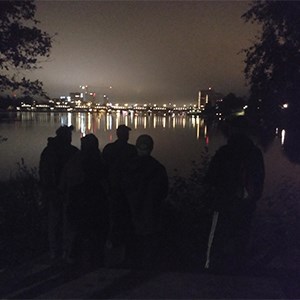Facts:
Project funded by SLU Urban Futures.
Name: Petter Axelsson
Department:Department of Wildlife, Fish and Environmental Studies
Faculty: Faculty of Forest Sciences
Contact: petter.axelsson@slu.se

Citizens’ science projects, in which the observations of thousands of people are systematically recorded, have a great potential for strengthening human-nature interactions in urban environments and contribute to scientific analyses of urban sustainability.
This project aimed at monitoring bats for mapping green infrastructure of conservational value in urban areas. Bats are important indicators of green infrastructure of conservational value, i.e. bats are indicators of high insect diversity, but humans rarely interact actively with bats. Still, throughout human history, these animals have fascinated humans, they are associated with great mythology, and as such, and they may be excellent organisms for engaging citizens in science projects and environmental monitoring. The problem is that bats are mainly nocturnal, are hard to detect by the human senses and as such they are rarely part of citizen science projects. The aim of this project was to provide citizens of Umeå and Uppsala with the technology needed for detecting the presence of bats in their gardens or close environment and thus help monitoring bat population and map green infrastructure of conservation value.
More than 100 people have borrowed a bat detector and reported their findings. Through these activities, participants have made more than 1020 separate observations and reported individual bat findings from 569 unique localities. Within the project two evening courses was arranged including bat excursions, one in Umeå and one in Uppsala, with 33 participants. Participants also took a survey on their attitudes and perception on nature and human nature interactions.
The project generated a lot of interest from the media, including Sveriges Radio, Nyhetsmorgon, Vetenskapsradion, Västerbottenskuriren, SVT Nyheter, SVT Västerbotten, Natursidan and Umeå X.
Based on the enormous interest in the project, we can safely say that bats fascinate people and thus can be a great organism group for citizens’ science projects. Furthermore, the data obtained from the citizen science project can contribute to scientific analyses of urban sustainability. Further analysis of the findings are to be made and more studies to explore the use of bats as indicator species for green corridors in urban environments would be an interesting development of the project.
Project funded by SLU Urban Futures.
Name: Petter Axelsson
Department:Department of Wildlife, Fish and Environmental Studies
Faculty: Faculty of Forest Sciences
Contact: petter.axelsson@slu.se
Fladdermöss ska kartläggas med frivilligas insatser (SLU news item in Swedish)
Låna en batscanner och bli fladdermusdetektiv
Umeås fladdermöss ska kartläggas
Bästa tipsen för att upptäcka Umeås fladdermöss
Så kan du bidra till forskningen om fladdermöss
Här kan du bli fladdermusdetektiv
Naturmorgon: Fladdermössen i Umeå och Uppsala ska kartläggas
Forskare ber om hjälp med att kartlagga fladdermöss
Så ska fladdermöss kartläggas av frivilliga